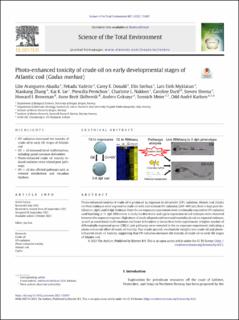Photo-enhanced toxicity of crude oil on early developmental stages of Atlantic cod (Gadus morhua)
Aranguren Abadía, Libe; Yadetie, Fekadu; Donald, Carey; Sørhus, Elin; Myklatun, Lars Eirik; Zhang, Xiaokang; Lie, Kai Kristoffer; Perrichon, Prescilla; Nakken, Charlotte Langeland; Durif, Caroline; Shema, Steven; Browman, Howard; Skiftesvik, Anne Berit; Goksøyr, Anders; Meier, Sonnich; Karlsen, Odd André
Journal article, Peer reviewed
Published version

Åpne
Permanent lenke
https://hdl.handle.net/11250/3028673Utgivelsesdato
2022Metadata
Vis full innførselSamlinger
- Department of Biological Sciences [2235]
- Registrations from Cristin [9791]
Originalversjon
Science of the Total Environment. 2022, 807 (Part 1), 150697. 10.1016/j.scitotenv.2021.150697Sammendrag
Photo-enhanced toxicity of crude oil is produced by exposure to ultraviolet (UV) radiation. Atlantic cod (Gadus morhua) embryos were exposed to crude oil with and without UV radiation (290–400 nm) from 3 days post fertilization (dpf) until 6 dpf. Embryos from the co-exposure experiment were continually exposed to UV radiation until hatching at 11 dpf. Differences in body burden levels and cyp1a expression in cod embryos were observed between the exposure regimes. High doses of crude oil produced increased mortality in cod co-exposed embryos, as well as craniofacial malformations and heart deformities in larvae from both experiments. A higher number of differentially expressed genes (DEGs) and pathways were revealed in the co-exposure experiment, indicating a photo-enhanced effect of crude oil toxicity. Our results provide mechanistic insights into crude oil and photo-enhanced crude oil toxicity, suggesting that UV radiation increases the toxicity of crude oil in early life stages of Atlantic cod.
